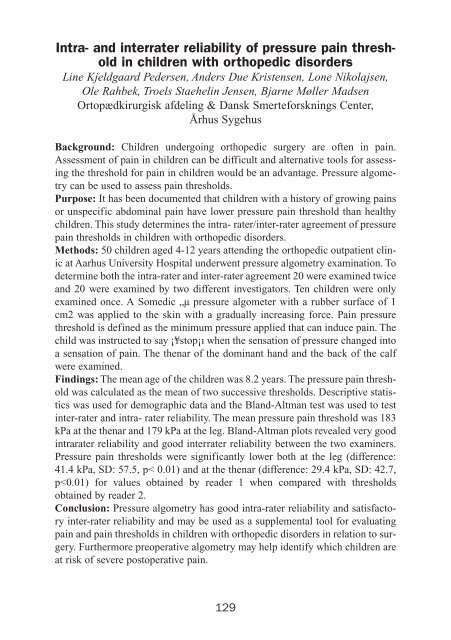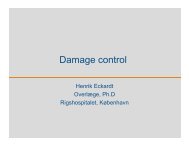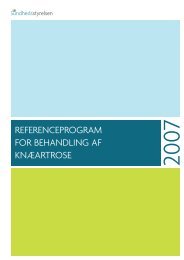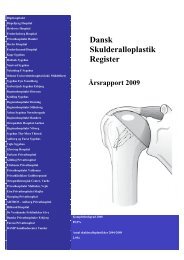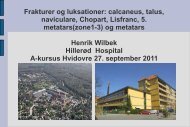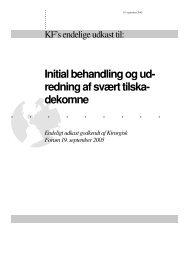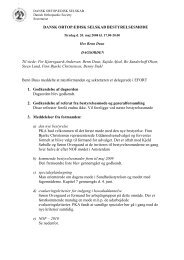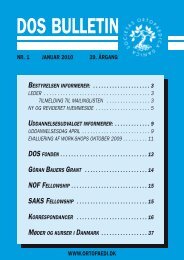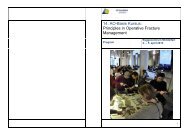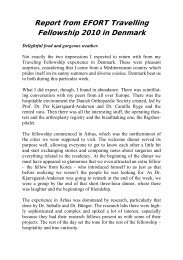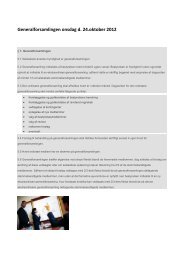DOS BULLETIN - Dansk Ortopædisk Selskab
DOS BULLETIN - Dansk Ortopædisk Selskab
DOS BULLETIN - Dansk Ortopædisk Selskab
Create successful ePaper yourself
Turn your PDF publications into a flip-book with our unique Google optimized e-Paper software.
2010-378_<strong>DOS</strong> nr. 3 2010 29/09/10 10:08 Side 129<br />
Intra- and interrater reliability of pressure pain threshold<br />
in children with orthopedic disorders<br />
Line Kjeldgaard Pedersen, Anders Due Kristensen, Lone Nikolajsen,<br />
Ole Rahbek, Troels Staehelin Jensen, Bjarne Møller Madsen<br />
Ortopædkirurgisk afdeling & <strong>Dansk</strong> Smerteforsknings Center,<br />
Århus Sygehus<br />
Background: Children undergoing orthopedic surgery are often in pain.<br />
Assessment of pain in children can be difficult and alternative tools for assessing<br />
the threshold for pain in children would be an advantage. Pressure algometry<br />
can be used to assess pain thresholds.<br />
Purpose: It has been documented that children with a history of growing pains<br />
or unspecific abdominal pain have lower pressure pain threshold than healthy<br />
children. This study determines the intra- rater/inter-rater agreement of pressure<br />
pain thresholds in children with orthopedic disorders.<br />
Methods: 50 children aged 4-12 years attending the orthopedic outpatient clinic<br />
at Aarhus University Hospital underwent pressure algometry examination. To<br />
determine both the intra-rater and inter-rater agreement 20 were examined twice<br />
and 20 were examined by two different investigators. Ten children were only<br />
examined once. A Somedic „µ pressure algometer with a rubber surface of 1<br />
cm2 was applied to the skin with a gradually increasing force. Pain pressure<br />
threshold is defined as the minimum pressure applied that can induce pain. The<br />
child was instructed to say ¡¥stop¡ı when the sensation of pressure changed into<br />
a sensation of pain. The thenar of the dominant hand and the back of the calf<br />
were examined.<br />
Findings: The mean age of the children was 8.2 years. The pressure pain threshold<br />
was calculated as the mean of two successive thresholds. Descriptive statistics<br />
was used for demographic data and the Bland-Altman test was used to test<br />
inter-rater and intra- rater reliability. The mean pressure pain threshold was 183<br />
kPa at the thenar and 179 kPa at the leg. Bland-Altman plots revealed very good<br />
intrarater reliability and good interrater reliability between the two examiners.<br />
Pressure pain thresholds were significantly lower both at the leg (difference:<br />
41.4 kPa, SD: 57.5, p< 0.01) and at the thenar (difference: 29.4 kPa, SD: 42.7,<br />
p


